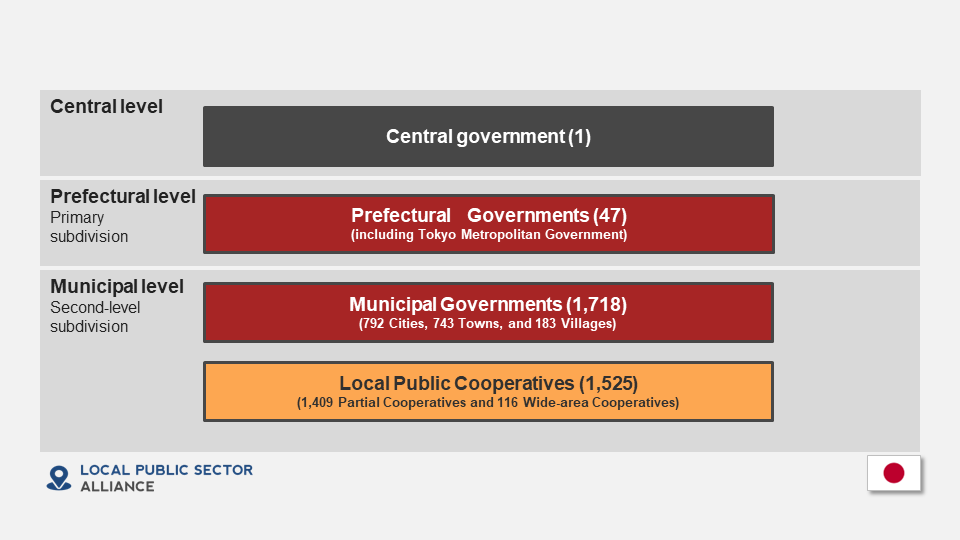
Japan, a small archipelago country by land area, has a population of 124.9 million, with over half of the country’s population concentrated in Tokyo, Osaka, and Nagoya. Local autonomy is ensured by the Constitution, adopting a “fusion type” system where central and local entities are mutually dependent. With 47 prefectures and 1,718 municipalities, local governments provide essential services, and recent amalgamations reduced the number of municipalities. They play a significant role in daily services like police, fire, education, and public welfare. Local government expenditures contribute substantially to the national economy. The 2000 Decentralization Reform aimed to empower local governments and enhance service quality.
Subnational government structure
Japan has a unitary structure with three levels of government: central, prefectural, and municipal. There are 47 prefectural governments and 1,718 municipalities, serving as the primary territorial subdivisions. Municipalities include cities, towns, and villages. Local public cooperatives, special local governments, are established to ensure efficient local public service delivery. Among them, 1,525 cooperatives exist, categorized as Partial Cooperatives (garbage disposal, fire services) and Wide-area Cooperatives (comprehensive affairs). Prefectural and municipal governments play crucial roles in providing public services, while cooperatives enhance efficiency for smaller municipalities.
Nature of subnational governance institutions
Prefectural and municipal governments are extensively devolved local entities in Japan, meeting key criteria of subnational governments—both in law, as well as in practice. All three entities possess independent corporate status, govern their respective territorial jurisdictions, and have their own elected political leadership. They also own assets, raise funds, prepare budgets, and appoint their own officers. While prefectural and municipal governments can levy taxes, local public cooperatives cannot. Prefectures and municipalities enjoy a high degree of autonomy without interference by higher-level government in their decision-making and operations. Local public cooperatives, indirectly governed, lack taxing powers and cater to areas like fire services and garbage collection. Given the limits on their functional responsibilities and more limited (de facto) autonomy from their parent-governments, they should be considered devolved local governments with limited powers and functions.
Functional assignments
Japan’s local autonomy, defined by the Local Autonomy Law (1947), grants broad administrative autonomy to local governments. The principle of municipal priority guides the distribution of functions among national government, prefectural and municipal governments. The national government focuses on matters of international concern and uniform nationwide activities, collaborating with local governments. Prefectural and municipal governments play distinct roles, with prefectures overseeing large-scale regional affairs, while municipalities handle diverse public services, highlighting their crucial role in providing essential services to citizens.
LoGICA Assessment
LoGICA Intergovernmental Profile: Japan 2023 (PDF / Excel)
Additional resources
Japan Country Profile (World Observatory on Subnational Governance and Investment, OECD/UCLG)
Local government country profile: Japan (UN Women)
Local Government in Japan (2022 Revised Edition). Council of Local Authorities for International Relations. (2022).
White Paper on Local Public Finance, 2023, Illustrated (FY2021 Settlement). Ministry of Internal Affairs and Communications, Government of Japan. (2023).
Back to Local Public Sector Alliance Intergovernmental Profiles – Country Page
Last updated: February 7, 2024
